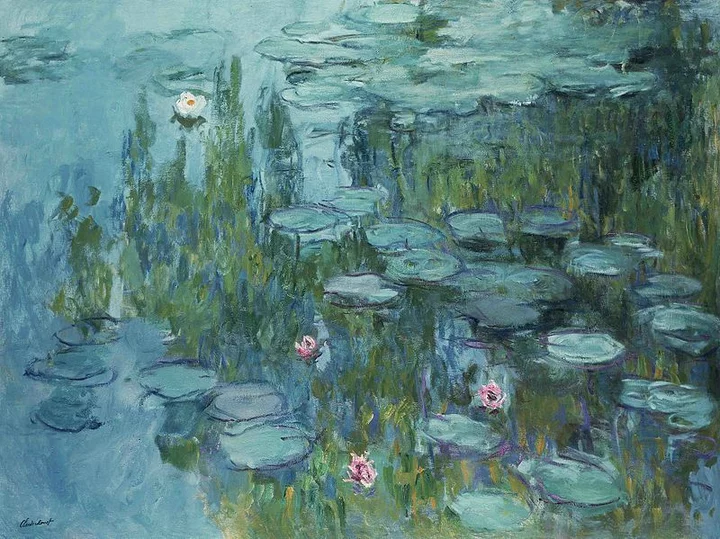Anyone
who has been around the printing industry, whether actually employed
in a printshop or as a customer, will be familiar with the initialism
CYMK, for cyan-yellow-magenta-black. The majority of printshops use
this “subtractive”
four-color system of inks (although, increasingly, six are now used)
to obtain realistic full-color images. Cyan, sometimes called
blue-green, is the complement of red: remove red from white light and
you get cyan. Similarly, yellow is white minus blue; magenta is white
minus green. That is, cyan, yellow and magenta are complementary to
the primary colors red, blue and green (RGB).

Claude Monet understood the power of cyan. Here’s one of his celebrated oils of “nymphéas” (water lilies) which he cultivated in a pond at his home in Giverny in northern France. He spent the last 20 years of his life painting them. (Public domain)
We see via two basic mechanisms: reflection and refraction. A photo in a magazine, for instance, uses the CYMK subtractive system: we see green that’s reflected after the ink has “subtracted” magenta from white that falls on the magazine. However, it’s pretty obvious that no print will ever match the vividness and intensity of a projected, refraction image, what we see on a TV or computer monitor. The phosphors, or LEDs, or OLEDs, that project colors to your eye — right now, on your phone, for instance — are red, green and blue, either (rarely) as pure colors or, normally, as mixtures of these three colors: the RGB system. (Here’s a primer on how the screen on your smartphone works.)
Turns out, few people have seen “true” cyan with the vividness that comes from a monitor. That’s because the color “gamut” that’s available to monitor designers doesn’t include a deep cyan, commonly called “real cyan.” So when a video turned up on the internet awhile back claiming that you could, indeed, see true cyan, it went viral overnight, along with many copycat versions. Here’s a static version: focus on the white dot while you count slowly to thirty, then look away. You’ll see a vivid cyan, and (hopefully) you’ll be amazed that this color was there all along for the taking, as it were, and you never knew. (Compare the bright color you see with the muted cyan — the best that your monitor or phone can do - -surrounding the red circle.)

For a richer experience, here’s a video that does the counting for you:
What’s going on? Most of the six-million-odd “cones” in your retina — about two-thirds — respond most strongly to red light. So when you’re staring at that red circle, those cones are excited — until they get fatigued. (This is the “after image” effect you get after staring at a light bulb — close your eyes and you see a dark shape of the bright bulb.) So when those red cones are effectively put out of action, your other cones, sensitive to green and blue light — together the complement of red — come into play. And voilá, cyan. Deep cyan. True cyan.
The first time I tried this, I was as astonished as the websites promoting the “illusion” (if that’s what it is) promised, even though I sort of knew what to expect. Fact is, real cyan is a lovely, lovely color, beyond words, and — up to that point — beyond my imagination. I’d love to hear your reaction if you’re seeing this for the first time.
CLICK TO MANAGE